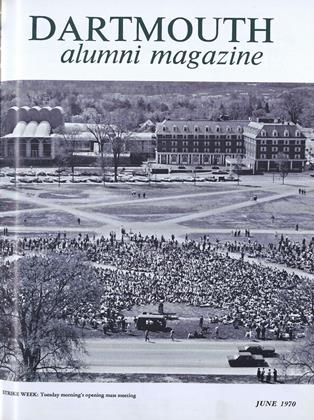Two things are important to realize concerning the publicity during the Dartmouth Community Strike. First, there was no tremendous deluge of publicity on campus influencing people to strike. Students here have lived all their lives under the influence of facts that led them to this decision. The only pre-strike publicity was a handwritten notice posted in a few key campus spots that read: STRIKE MEETING, 9:00 p.m., North Fayer Lounge. There was no debate. There was no need for debate. A strike was the logical outcome of the publicity efforts over the last ten years by NBC, CBS, ABC, TheNew York Times, Time, Look, Life, and other national news media.
Secondly, there was a tremendous deluge of publicity after the strike began. The basic goal of the Publicity Committee was not to push any specific line or idea, but rather to be available for any individual or group who wished to spread the word about their particular activities. Reams of material for signs, information sheets, position papers, petitions, notes on how to write Congressmen, fact sheets on the war and repression, and anything else people felt might help the effort were produced. Action feeds on information, and information was reproduced as fast as it was brought in.
The single most important function of publicity was the nightly publication of the Strike Newsletter, a six-to-twelve-page information sheet listing all the day's workshops, meetings, and other relevant news. This information was compiled during the day at the Strike Center at the Top of the Hop, edited during the evening, then typed, printed, collated, stapled, and delivered by a host of anonymous and tremendously committed individuals. All this was completed in the dark and tired hours between midnight and dawn.
Although the publicity effort formed only a portion of the energy and action of the strike movement, it successfully represented the total enthusiasm, energy, and activity of the entire community.
 View Full Issue
View Full Issue
More From This Issue
-
 Feature
FeatureFor Want of a Better Word They Called It a Strike
June 1970 By DAVID MASSELLI '70 and WINTHROP ROCKWELL '70 -
 Feature
FeatureSix Professors Reach Retirement
June 1970 -
 Feature
FeatureNew Environmental Studies Program To Be Launched in the Fall
June 1970 By ROBERT B. GRAHAM '40 -
 Feature
FeatureThe Class Officers Weekend
June 1970 -
 Article
ArticlePRESIDENT KEMENY'S RADIO TALK
June 1970 -
 Article
ArticleWhat the Workshops Meant
June 1970 By GUY DE MALLAC-SAUZIER







